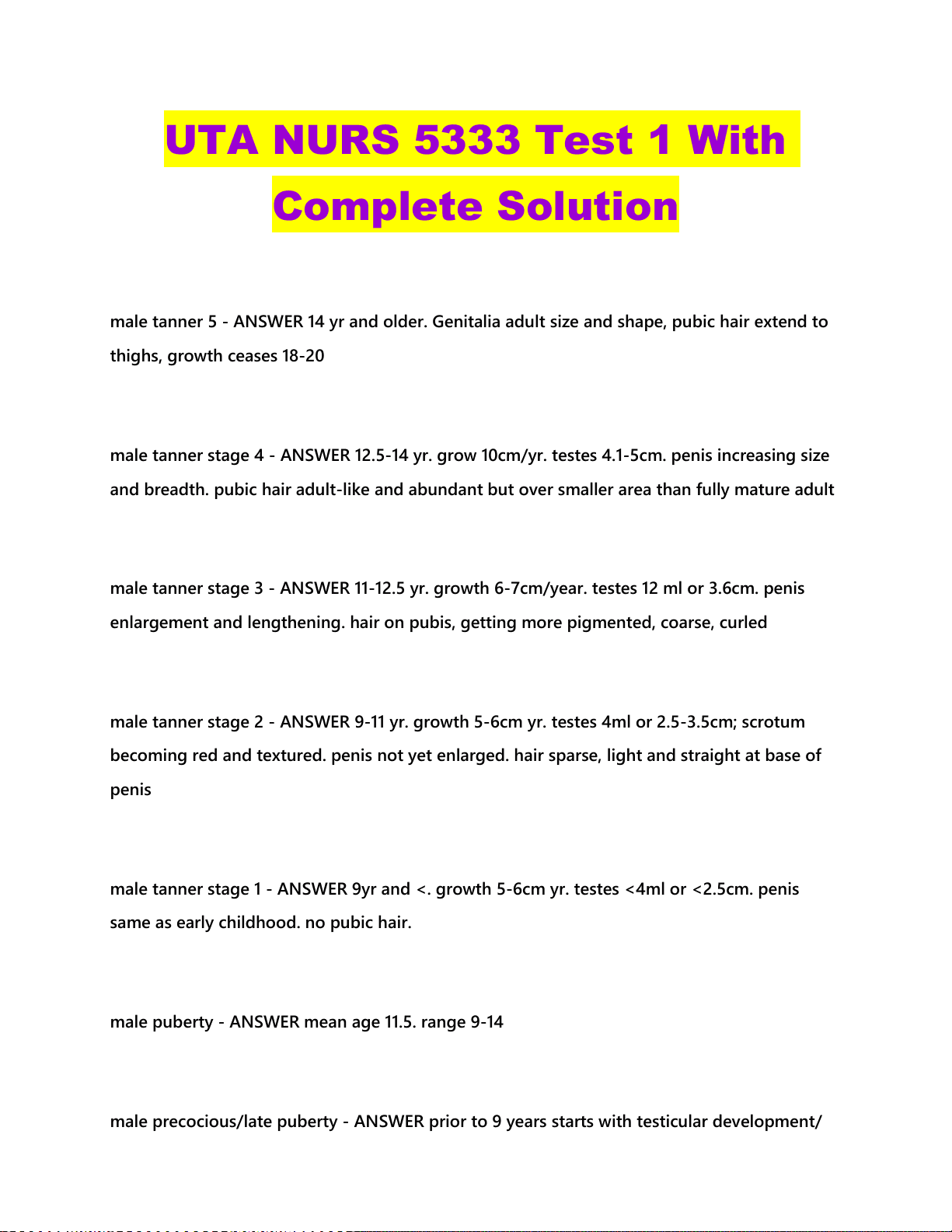
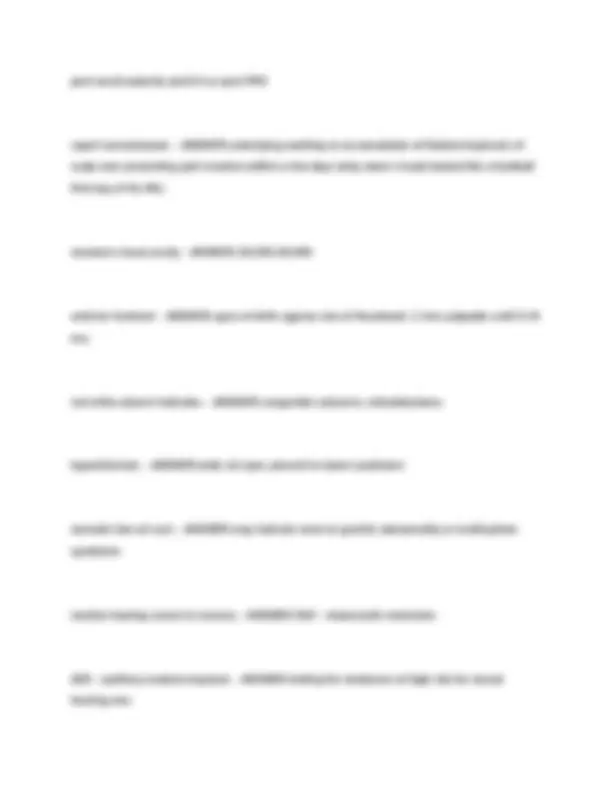
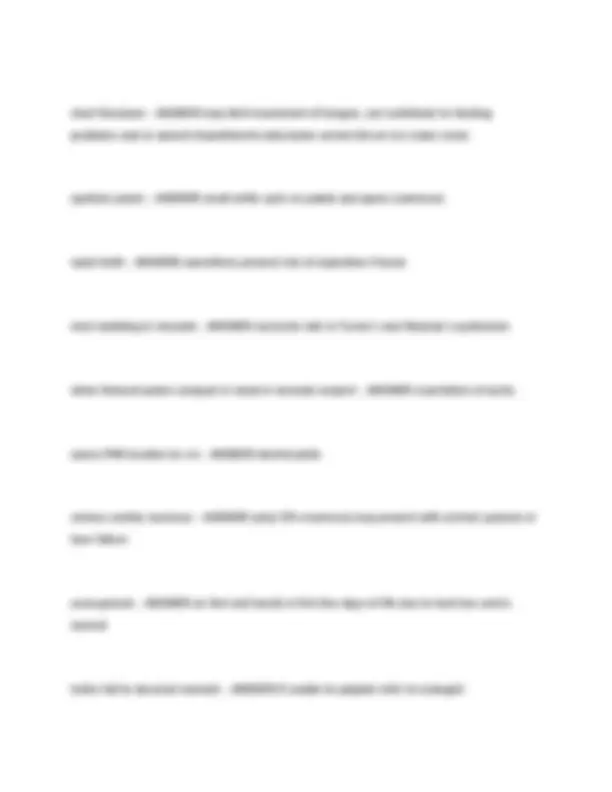
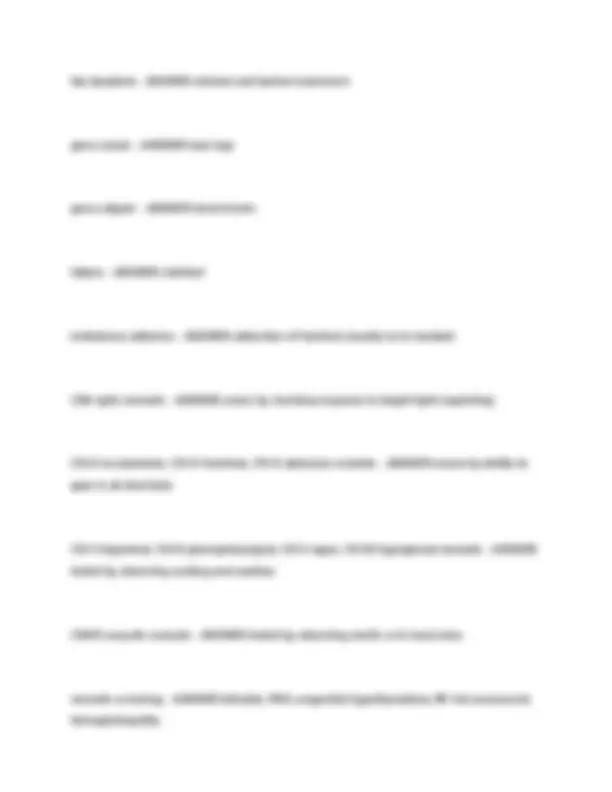
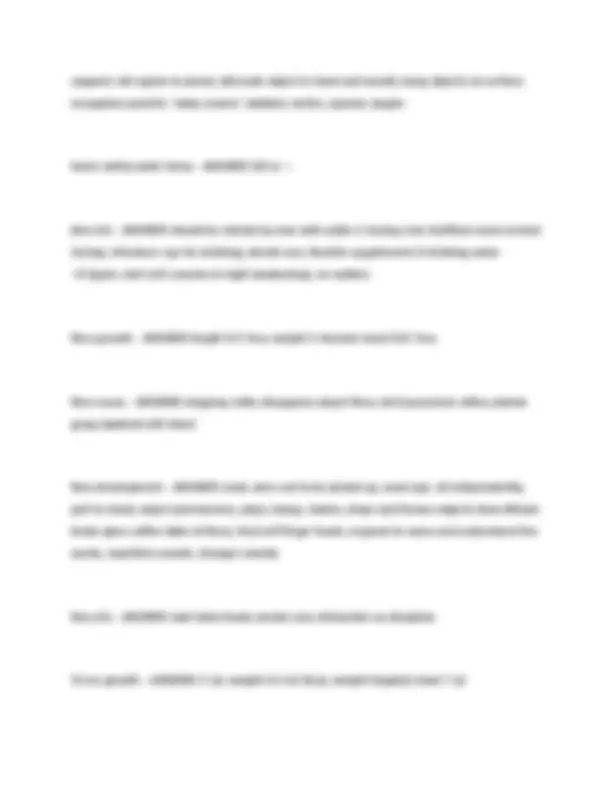
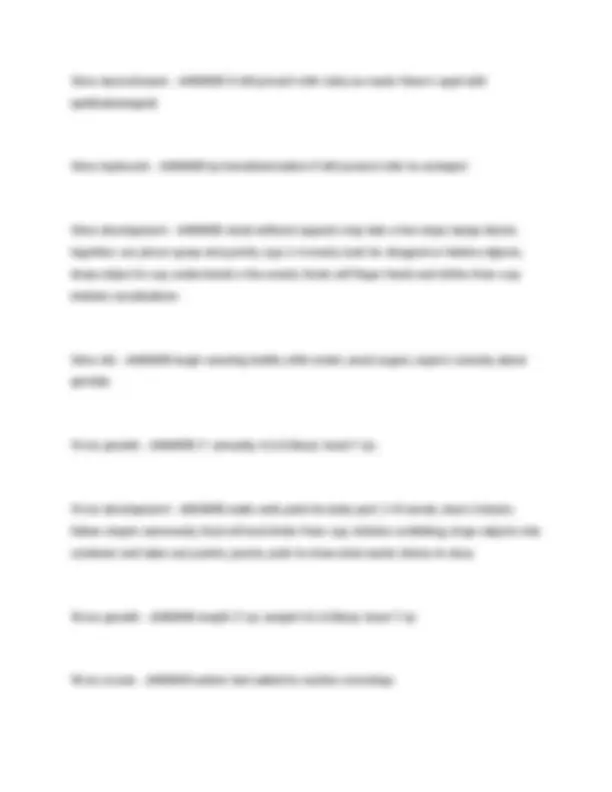
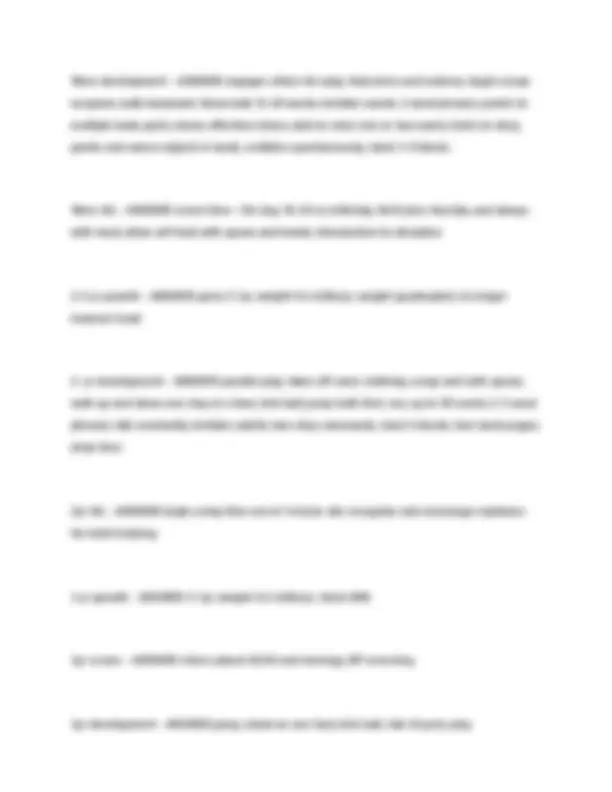
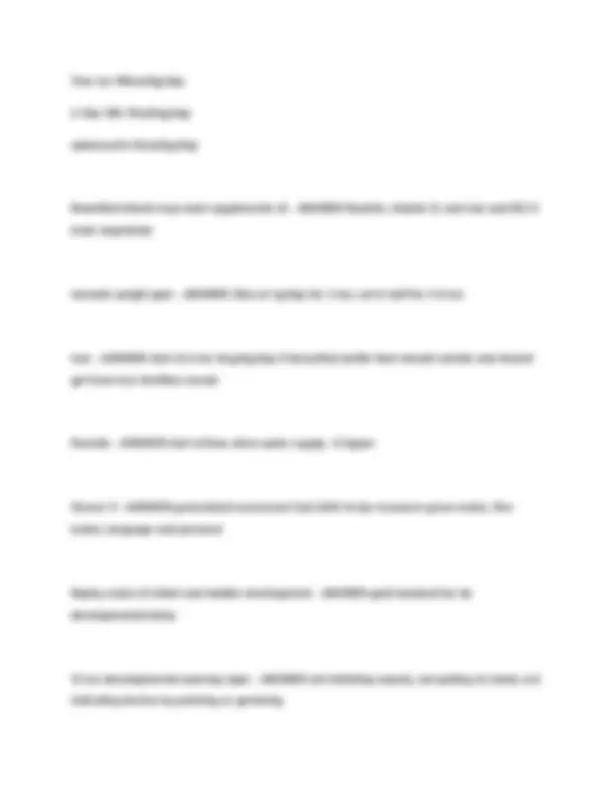
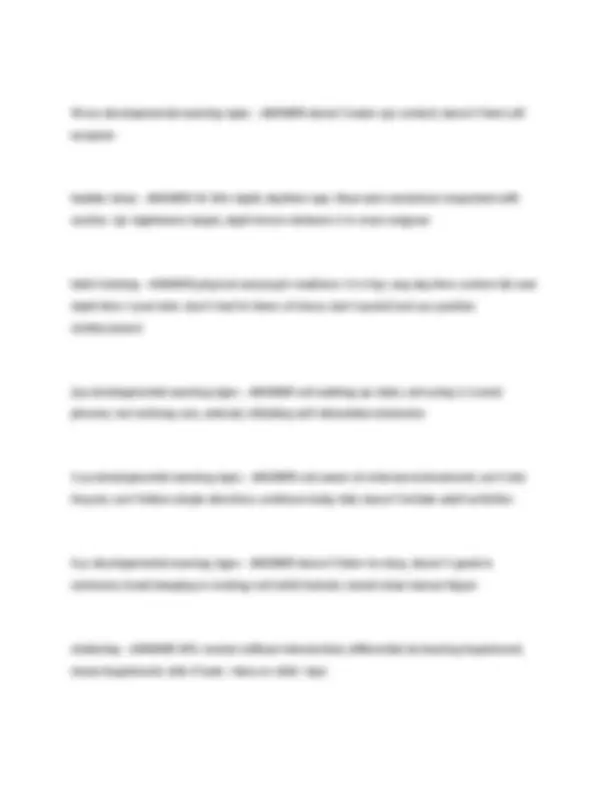
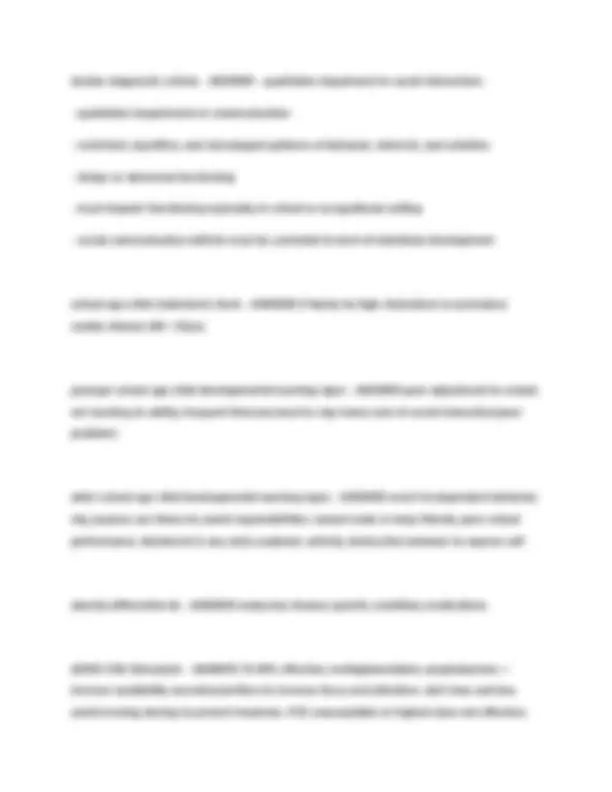
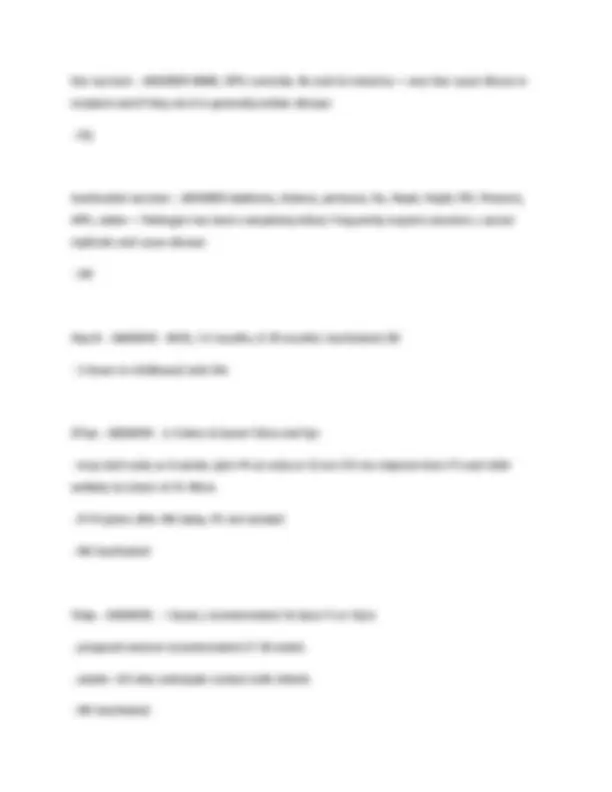
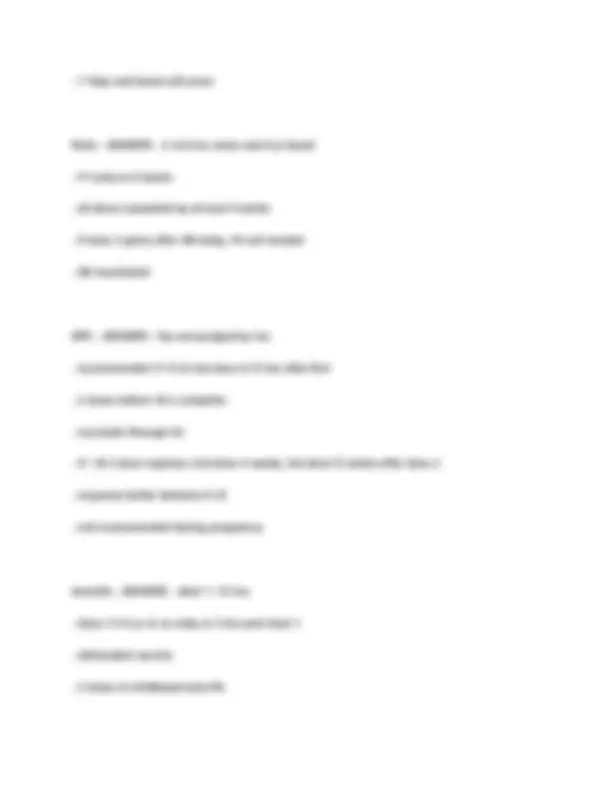
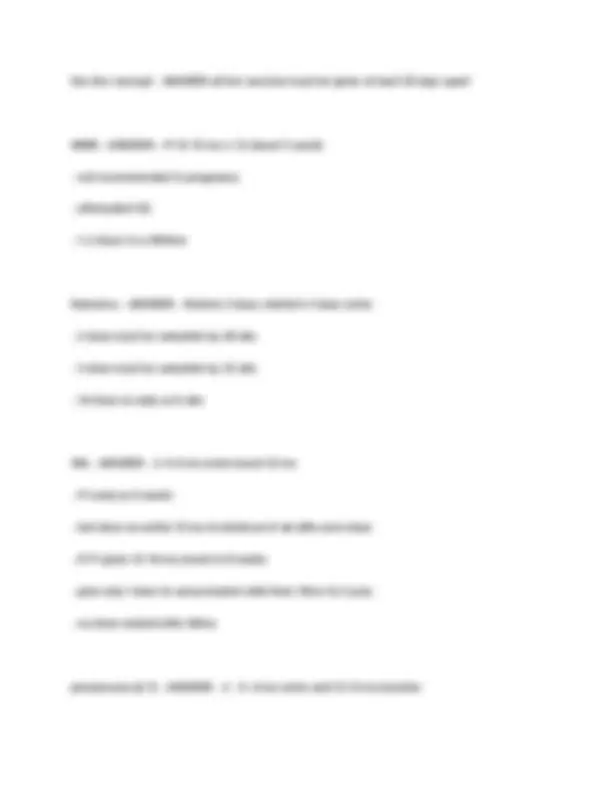
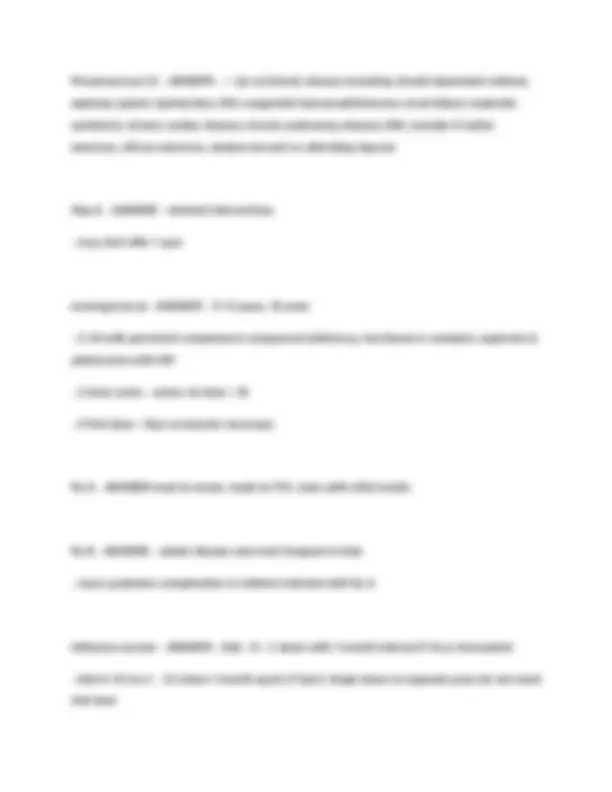
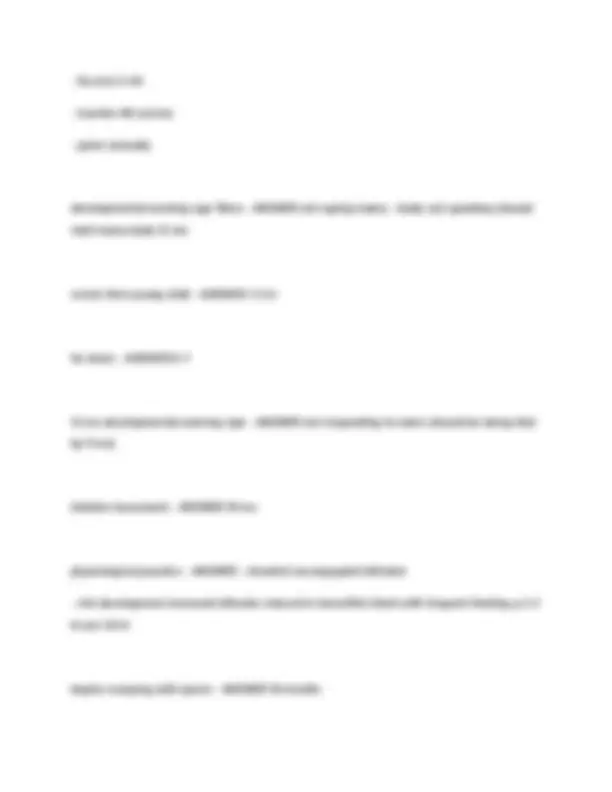
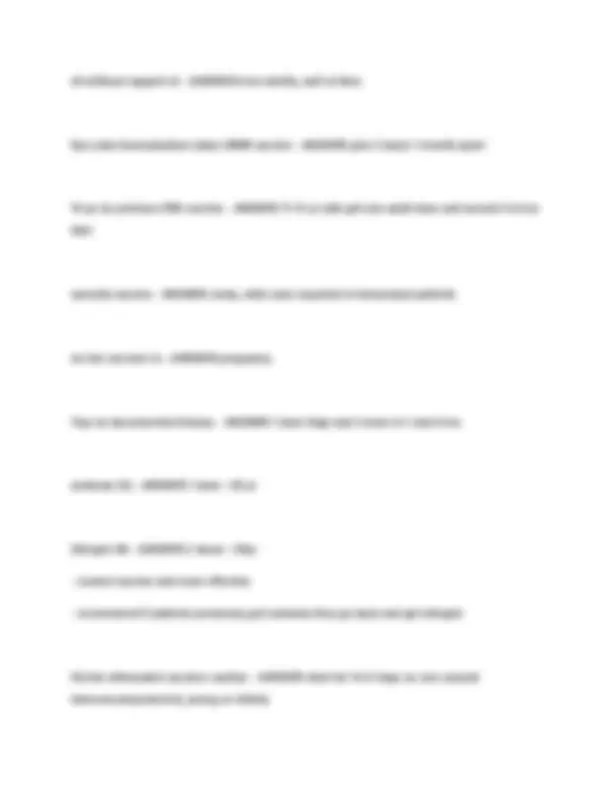
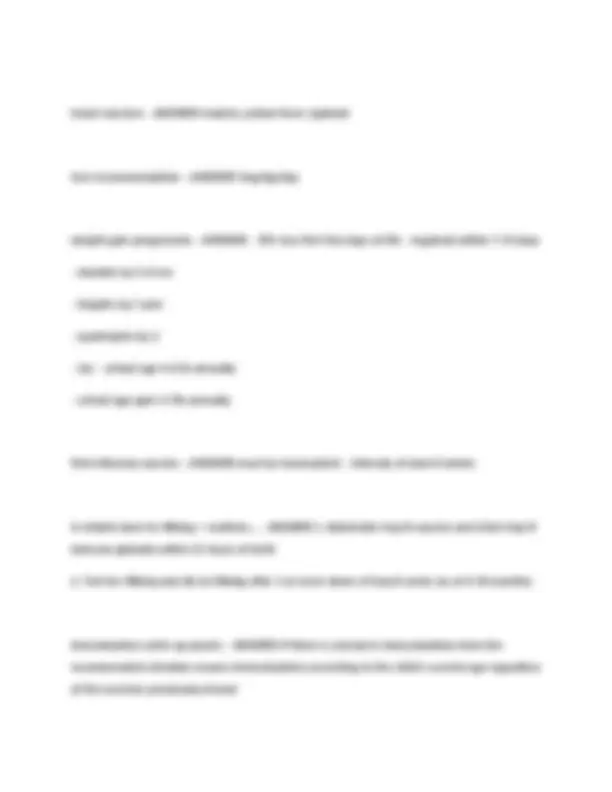



Study with the several resources on Docsity

Earn points by helping other students or get them with a premium plan


Prepare for your exams
Study with the several resources on Docsity

Earn points to download
Earn points by helping other students or get them with a premium plan
Community
Ask the community for help and clear up your study doubts
Discover the best universities in your country according to Docsity users
Free resources
Download our free guides on studying techniques, anxiety management strategies, and thesis advice from Docsity tutors
A detailed overview of child development milestones from infancy to age four, encompassing physical growth, neurological development, and key developmental assessments. it includes tanner stages for male and female puberty, common neonatal findings, and age-appropriate anticipatory guidance for healthcare providers. The information is presented in a concise question-and-answer format, making it a valuable resource for students and professionals alike. it covers topics such as newborn reflexes, developmental screenings, and common childhood conditions.
Typology: Exams
1 / 25

This page cannot be seen from the preview
Don't miss anything!


















male tanner 5 - ANSWER 14 yr and older. Genitalia adult size and shape, pubic hair extend tothighs, growth ceases 18-
male tanner stage 4 - ANSWER 12.5-14 yr. grow 10cm/yr. testes 4.1-5cm. penis increasing sizeand breadth. pubic hair adult-like and abundant but over smaller area than fully mature adult
male tanner stage 3 - ANSWER 11-12.5 yr. growth 6-7cm/year. testes 12 ml or 3.6cm. penisenlargement and lengthening. hair on pubis, getting more pigmented, coarse, curled
male tanner stage 2 - ANSWER 9-11 yr. growth 5-6cm yr. testes 4ml or 2.5-3.5cm; scrotumbecoming red and textured. penis not yet enlarged. hair sparse, light and straight at base of penis male tanner stage 1 - ANSWER 9yr and <. growth 5-6cm yr. testes <4ml or <2.5cm. penissame as early childhood. no pubic hair.
male puberty - ANSWER mean age 11.5. range 9- male precocious/late puberty - ANSWER prior to 9 years starts with testicular development/
late 13- female tanner stage 1 - ANSWER 10 and <. grow 5-6cm/yr. breasts papilla elevated abovechest wall. no pubic hair
female tanner stage 2 - ANSWER 10-11.5yr. grow 7-8cm/yr. breasts and papilla form smallmound; areola increases in diameter. hair sparse, light, straight along labial border
female tanner stage 3 - ANSWER 11.5-13 yrs. grow 8cm/yr. breast and areola enlarge; noseparation in contour. hair on pubis more coarse, pigmented and curled
female tanner stage 4 - ANSWER 13-15 yrs. grow 7cm/yr. secondary mound formed by areolaand papilla about level of breast. hair adult like just over smaller area than fully mature adult
female tanner stage 5 - ANSWER 15 and >. growth ceases 2-2.5yr post menarche. adult breast;nipple projects; areola becomes part of contour of breast; adult in type and quantity and extends to thighs female precocious/late puberty - ANSWER 8/12- female puberty - ANSWER begins with breast development. mean onset 10.5. range 8- menarche - ANSWER 9-15 after breast, pubic and underarm hair begin to grow. avg 2.6 yr
short frenulum - ANSWER may limit movement of tongue, can contribute to feedingproblems and or speech impediments (why kylee cannot lick an ice cream cone)
epsteins pearls - ANSWER small white cysts on palate and gums (common) natal teeth - ANSWER sometimes present: risk of aspiration if loose neck webbing in neonate - ANSWER excessive skin in Turner's and Noonan's syndromes when femoral pulses unequal or weak in neonate suspect - ANSWER coarctation of aorta assess PMI location to r/o - ANSWER dextrocardia serious cardiac murmurs - ANSWER (only 10% murmurs) may present with central cyanosis orhear failure
acrocyanosis - ANSWER on feet and hands in first few days of life due to heat loss and isnormal
testes fail to descend neonate - ANSWER if unable to palpate refer to urologist
hip dysplasia - ANSWER ortolani and barlow maneuvers genu varum - ANSWER bow legs genu valgum - ANSWER knock knees talipes - ANSWER clubfoot metatarsus adductus - ANSWER adduction of forefoot (usually no tx needed) CNII optic neonate - ANSWER assess by checking response to bright light (squinting) CN III occulomotor, CN IV trochlear, CN VI abducens neonate - ANSWER assess by ability togaze in all directions
CN V trigeminal, CN IX glossopharyngeal, CN X vagus, CN XII hypoglossal neonate - ANSWERtested by observing sucking and swallow
CNVIII acoustic neonate - ANSWER tested by observing startle rx to loud noise neonate screening - ANSWER bilirubin; PKU; congenital hypothyroidism; BP risk assessment;hemogloinopathy
2mo development - ANSWER focus on face, Coos, grasps rattle, smiles responsively, lifts head45 degree, turns head to sound, step reflex
4mo growth and weight - ANSWER length 1"; weight 1oz/day; head 0.5"/mo rooting reflex - ANSWER present at birth. by 4mo present only in sleep 4mo development - ANSWER focus on face; grasp rattle; smile; coo; laugh; recognizecaregiver voice and touch; hold and control head when upright without lag when pulled upright; roll prone to supine; play with fingers midline 4mo AG - ANSWER begin teething discussion; childproofing; introduction solid foods (cerealfirst) around 6mo
6 mo growth - ANSWER length 0.5"/mo; weight 3-4oz/week. weight should have doubled bynow (5-6mo). head 0.25"/mo
tooth eruption 6mo - ANSWER lower central incisors 6mo; lower lateral incisors 7mo; uppercentral incisors 7.5mo
reflex disappears about 6 mo - ANSWER moro (startle) and fencing 6mo development - ANSWER respond to name; bear weight and stands; sit briefly without
support; roll supine to prone; alternate object in hand and mouth; bang objects on surface;recognizes parents; "dada, mama"; babbles; smiles, squeals, laughs
home safety water temp - ANSWER 120 or < 6mo AG - ANSWER should be started by now with solids 2-3x/day; iron fortified cereal at least2x/day; introduce cup for drinking; dental care; fluoride supplements if drinking water <0.3ppm; start self-console at night awakenings; no walkers 9mo growth - ANSWER length 0.5"/mo; weight 3-4oz/wk; head 0.25"/mo 9mo neuro - ANSWER stepping reflex disappears about 9mo; elicit parachute reflex; plantargrasp babinski still intact
9mo development - ANSWER crawl, arms out to be picked up, wave bye, sit independently,pull to stand, object permanence, plays, bangs, shakes, drops and throws objects (how Miriam broke glass coffee table at 9mo), feed self finger foods, respond to name and understand fewwords, repetitive sounds, stranger anxiety
9mo AG - ANSWER start table foods; dental care; distraction as discipline 12 mo growth - ANSWER 3"/yr; weight 4.5-6.5 lb/yr; weight trippled; head 1"/yr
18mo development - ANSWER engages others for play; help dress and undress; begin scoopw/spoon; walk backward; throw ball; 15-20 words; imitates words; 2 word phrases; points to multiple body parts; shows affection; kisses; able to voice one or two wants; listen to story,points and names objects in book; scribbles spontaneously; stack 3-4 blocks
18mo AG - ANSWER screen time <1hr day; 16-24 oz milk/day; limit juice 4oz/day and alwayswith meal; allow self feed with spoon and hands; introduction to discipline
2-3 yr growth - ANSWER grow 3"/yr; weight 4.5-6.5lb/yr; weight quadrupled; no longermeasure head
2- yr development - ANSWER parallel play; takes off some clothing; scoop well with spoon;walk up and down one step at a time; kick ball; jump both feet; run; up to 50 words; 2-3 word phrases; talk constantly; imitates adults; two-step commands; stack 5 blocks; turn book pages;draw lines
2yr AG - ANSWER begin using time out at 1 min/yr old. recognize and encourage readinessfor toilet training
3 yr growth - ANSWER 3"/yr; weight 4.5-6.5lb/yr; check BMI 3yr screen - ANSWER vision (about 20/50 and hearing); BP screening 3yr development - ANSWER jump; stand on one foot; kick ball; ride tricycle; play
cooperatively and share; imaginary play; climb chairs and couch; state name, age, sex;900word vocab; 3 word sentences; sex of others; copy circle and cross; recognize colors; daytime toilet training achieved; eat independently; language generally understood 4 yr growth - ANSWER 3"/yr; weight 4.5-6.5lb/yr; head 1"/yr 4yr development - ANSWER sing song; 4 word sentences; hop one foot; alternate feetclimbing stairs; draw person w/3 parts; cut and paste; tower 10 blocks; say first and last name; count to 5; copy a square; dress with supervision; button and unbutton large buttons 5-6yr growth - ANSWER 2.5-3"/yr; weight 4.5-6.5lb/yr; head negligible 5-6yr eyes - ANSWER 5yr 20/30; 6 yr 20/20; PERRLA 5-6yr development - ANSWER draw person 6 body parts; print/recognize letters/numbers;plays make believe; learns address and phone number; define at least 1 word; counts on fingers and to 10; name 4 or more colors; copy square and triangle; dress self; hop, skip,tiptoe; understand right and wrong; plays cooperatively and enjoys playmates; good clarity, articulation, language skills 5-6yr AG - ANSWER at least 60min/day physical activity; 7-8yr growth - ANSWER 2.5"/yr; weight 5-7lb/yr; BMI assess for childhood obesity
7mo-1yr 100cal/kg/day 2-10yr 100-70cal/kg/day adolescents 45cal/kg/day Breastfed infants may need supplements of - ANSWER fluoride, vitamin D, and iron and B12 ifmom vegetarian
neonate weight gain - ANSWER 30oz or 1g/day for 3 mo; cut in half for 3-6 mo iron - ANSWER start at 6 mo 1mg/kg/day if breastfed; bottle feed should contain and shouldget from iron fortified cereals
fluoride - ANSWER start at 6mo when water supply <0.3ppm Denver II - ANSWER generalized assessment tool birth to 6yr measures gross motor, finemotor, language and personal
Bayley scales of infant and toddler development - ANSWER gold standard for dxdevelopmental delay
12 mo developmental warning signs - ANSWER not imitating sounds, not pulling to stand, notindicating desires by pointing or gesturing
18 mo developmental warning signs - ANSWER doesn't make eye contact; doesn't feed selfw/spoon
toddler sleep - ANSWER 10-12hr night; daytime nap; ritual and consistence important withroutine. 3yr nightmares begin; night terrors between 2-6. most outgrow
toilet training - ANSWER physical and psych readiness 1.5-2.5yr; avg day time control @2 andnight time 1 year later. don't start in times of stress; don't punish but use positive reinforcement 2yo developmental warning signs - ANSWER not walking up stairs; not using 2-3 wordphrases; not noticing cars, animals; initiating self-stimulation behaviors
3 yo developmental warning signs - ANSWER not aware of external environment; can't ridetricycle; can't follow simple direction; continues baby talk; doesn't imitate adult activities
4 yr developmental warning signs - ANSWER doesn't listen to story; doesn't speak insentences; head banging or rocking; not toilet trained; cannot draw human figure
stuttering - ANSWER 50% resolve without intervention; differential dx hearing impairment,visual impairment; refer if lasts >6mo or child >6yo
switch to another stimulant first ADHD non stimulants - ANSWER atomoxetine; bupropion cautions of ADHD meds - ANSWER CV disease; HTN; anxiety; depression; glaucoma; drugabuse hx; suicide risk
ADHD meds side effects - ANSWER insomnia; anorexia; weight loss; tachy; tolerance; tics; HA;stomach aches; temporary slow rate growth and development
HEADSS - ANSWER home education/employmentpeer group activities drugs sexuality suicide depression PACES - ANSWER Parents, peers Accidents, alcohol/drugs Cigarettes Emotional issues
School, sexuality SAFETEENS - ANSWER sexualityalcohol firearms emotions toxins environments exercise nutrition shots CRAFT - ANSWER car w/someone on toxins Relax with toxins alone while using toxins forget what done while on toxins family or friends tell you to cut down trouble while on toxins Russell's sign - ANSWER bruised knuckels from self induced vomiting
live-live concept - ANSWER all live vaccines must be given at least 28 days apart MMR - ANSWER - #1 12-15 mo (<12 doesn't count)- not recommended in pregnancy